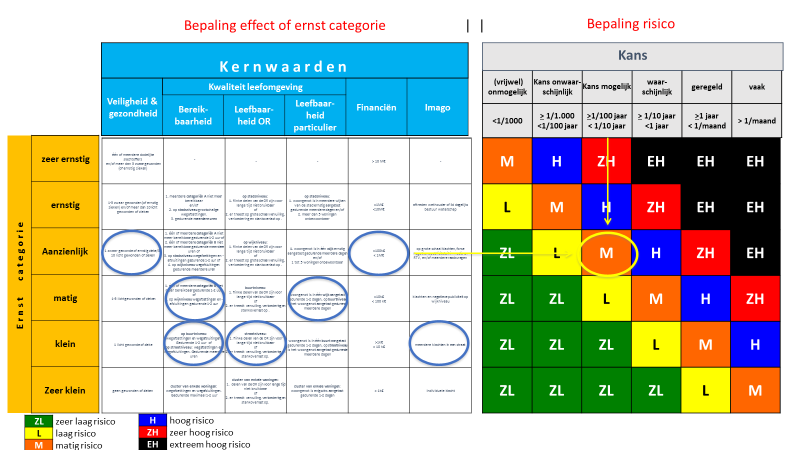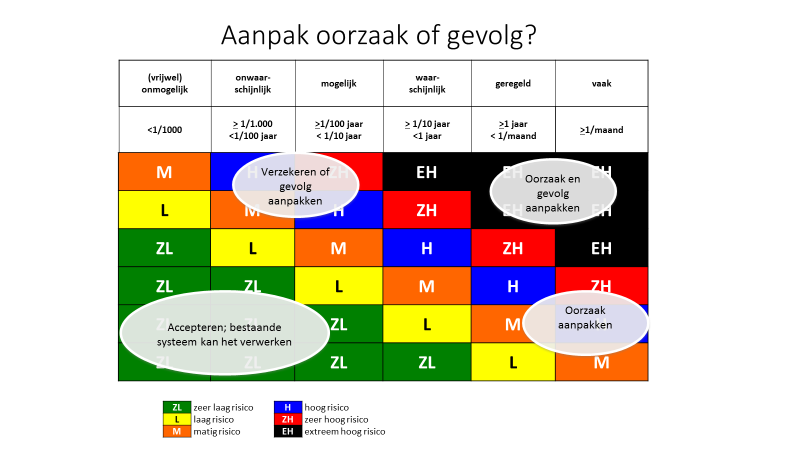Risk dialogue on waterlogging in Enschede
The municipality of Enschede embarked on a risk dialogue regarding waterlogging and phreatic waterlogging as early as 2014. At that time, it was referred to as “risk-based water management” rather than a risk dialogue. The authorities in charge of water systems mapped out the risks and how they affected municipal core values. Subsequently, they entered into a dialogue: what risks do we find acceptable and how much money are we willing to spend on reducing such risks?
Reason for the dialogue: good water management at acceptable costs
The municipality of Enschede is pursuing risk-based water management and is thus substantiating the risk dialogue regarding waterlogging. The municipal authorities introduced this system in 2012 in order to prevent a sharp rise in sewerage charges and to be able to make acute choices regarding which work is given priority, and why. In order to continue to fulfil its duty of care regarding municipal water management, with fewer resources, the municipality needed to devise an assessment framework. That is why, at that time, it initiated a testing ground in collaboration with the RIONED foundation [interest group for urban drainage issues], the Foundation for Applied Water Research STOWA, and the Regge en Dinkel district water board. The key question was: “How can we level off the rising costs of urban water management, while making transparent choices in the things we will and will not do, for the benefit of residents and businesses?” This generated a system to support the assessment of risks in water management.
The object of the dialogue: “Looking for a balance”
The goal of risk-based water management is to enter into a dialogue on vulnerable locations, the effects and risks that may arise at such locations, and whether these need to be tackled. The process also involves an exploration of the measures that may be implemented to reduce the risks and the costs of such measures. Subsequently, a balance is sought between acceptance of the scope of the risks (the risk profile) and the costs of the measures. In many cases, initially only few risks are deemed acceptable, until insight is provided into the measures required and the costs of such measures (and their subsequent impact on the sewerage charges). This sparks off a debate on the viability and desirability of various strategies. This debate fosters awareness of the risks, the solutions that the municipality can implement, and the solutions that are feasible on private properties.
Parties involved in the dialogue: knowledge partners and the municipal council
The risk-based management started at the municipal authorities in charge of water management. They developed the system in collaboration with other municipal disciplines, such as roads, greenery, and traffic, and with knowledge partners such as RIONED, STOWA, and the Community Health Service. Exchanging information and experience with these parties enabled the authorities to better assess various effects. For example, the Community Health Service provided information on the health effects of phreatic waterlogging. By involving parties from beyond the water domain, the impact of (phreatic) waterlogging was explored from a wider perspective.
Subsequently, together with the municipal council, the authorities set down which risks they would accept and where action is required. In the dialogue with the council, they continuously pursued a balance between “accepting a risk” or “taking measures”, with the potential consequence of incurring additional expenses and the necessity of raising sewerage charges. Residents have not yet been approached directly with the question of which risks are acceptable and which are not. However, residents are closely involved in the design of measures, in order to realise solutions that are geared to local requirements.
Format of the risk dialogue: risk-based management system
The risk-based management system is based on the following definition: risk = probability x effect. A risk table has been developed to support the decision-making process. The first step involves determination of the impact of an event on the municipal core values, issues deemed of paramount importance by the municipality. The core values of the municipality of Enschede are: Security & Health, Accessibility, Liveability of Public Space, Liveability of Private Property, Finances (such as damage), and Image. The risk is determined by combining the highest possible impact of an event with the probability of such an event occurring. The image below gives an impression of this process.

Image: Matrix for risk assessment.
An example of such an event is the occurrence of waterlogging in a residential area. Such an event may impact all the core values. For example, if people are hurt or fall ill as a result of waterlogging, this will impact the core value of “Security and Health”. Accessibility is impacted if waterlogging prevents people from driving through streets and if they cannot reach certain destinations. Damage may occur if water enters houses. The seriousness of an impact category will rise proportionately to the number of people hurt or fallen ill, to the extent of a road’s traffic function, or to the scope of the damage caused to houses. In residential streets, the seriousness category of an impact will usually be lower compared to busy access roads or shopping precincts.
The highest impact is transferred to the risk matrix (see the right side of the illustration above). In this case, the seriousness of the impact is “considerable”: the return frequency of the downpour causing the waterlogging is once every 100 years. This impact and this probability together determine the risk. In this example, the risk is “moderate”. Whether measures need to be taken is dependent on the (maximum) acceptable risk. If the risk is too high, measures must be taken. Which type of measure is most appropriate is determined on the basis of the line of thought reflected in the illustration below:

Image: Matrix to determine the type of measure.
Another consideration, in addition to this approach, is the cost effectiveness of the measure.
In 1988, in order to gain insight into the impact of waterlogging, the municipality introduced a sewerage model. In 2014, a stress test was conducted, based on the risk-based system, for the entire urban area, with respect to both the current situation and the situation following climate change. The outcomes of this stress test, combined with the risk dialogue conducted with the municipal council, have resulted in an implementation programme. This programme has been embedded in the Municipal Sewerage Plan. Several measures have already been implemented or are being prepared. Examples include the construction of the Urban Brook and consideration of waterlogging in the Oldenzaalsestraat. In addition to the efforts being expended under the implementation programme, water storage and water resilience are taken into account in each municipal design tasking, while mandatory water storage is embedded in the zoning plan for new housing developments.
Follow-up to the risk dialogue
The municipal risk dialogues are currently focused only on waterlogging and phreatic waterlogging. When implementing waterlogging measures, the municipality uses the national climate impact atlas to explore whether the locations are also prone to heat or drought issues. Wherever possible, measures to combat such issues are included in the process. The same applies to themes such as liveability, biodiversity, traffic, and social issues. At the regional level, in-depth stress tests will be conducted with respect to heat and drought. Such stress tests will serve as the basis for well-substantiated assessments to underpin risk dialogues for these issues.
With respect to the risk-based water management system, the authorities intend to continually gather more information on the potential impact of waterlogging, the probability of waterlogging, and cost-effective measures. This will enable ever more efficient comparative assessments. To this end, the RIONED foundation has made an “Urban Water Management Risk Database” available; this database will be supplemented in the years ahead.
Lessons to be learned
- Liaise policy-makers and the municipal council at an early stage in order to enter into a dialogue regarding risks. Risk-based management calls for a different approach compared to traditional water management: considering the effects that may arise rather than taking standards as one’s point of departure, considering the frequency of such effects, and what is deemed acceptable or not. This is weighed against the costs of measures to reduce such risks. Risk assessment and decision-making require a process involving several iterations, whereby stakeholders gradually gain insight into the risks and the costs involved in lowering the risk profile.
- Use understandable language to enter into a dialogue regarding risks. In order to develop an assessment framework in concert with parties from different backgrounds, it is important not to resort to water domain lingo. Address topics that everyone understands. That is why Enschede has opted for working with core values. The dialogues deal with topics such as the acceptance of people falling ill or getting hurt, or the acceptance of damage and how frequently damage may occur.
- Risk-based management can be adopted in every municipality. The risk tables have specifically been tailored to the core values of the municipality of Enschede, yet the method bears generic application. Everyone can formulate his or her core values and indicate which event falls into which impact category. The report entitled “Proeftuin Enschede: risicogestuurd (afval)waterbeheer (pdf, 1.1 MB)” [Enschede Testing Ground: risk-based (waste) water management] sets out more details on risk-based water management.
Contact persons
Rik MeijerGemeente EnschedeR.Meijer@enschede.nlHendrikjan TeekensGemeente Enschedehj.teekens@enschede.nl
